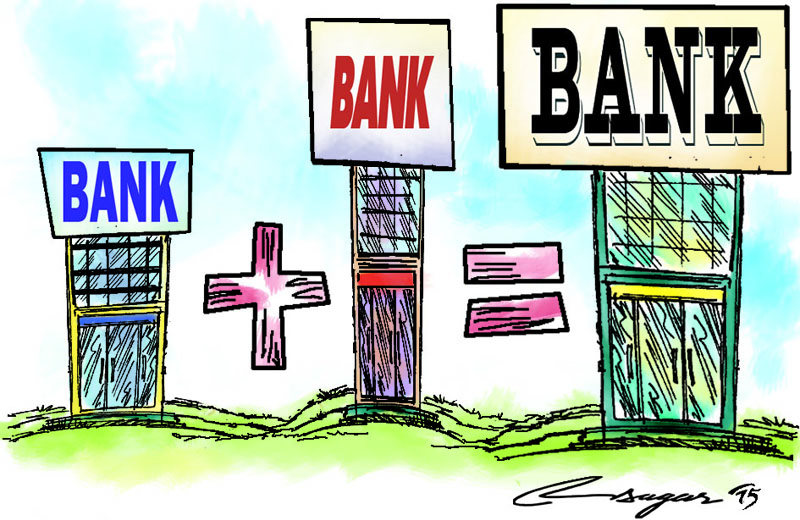New monetary policy: Paid-up capital hike
Nepal Rastra Bank, ‘the watchdog’ of the Nepalese financial market, has issued a new monetary policy for the fiscal year 2015/16. The increased requirement of paid up capital for banking institutions of all categories has hit the floor and made it a hot issue among the bankers, policy makers, public, and other stakeholders. ‘The watchdog’ bodies are citing that the move to raise the paid up capital was taken to strengthen the BFIs, make them competitive and bring financial stability. However, bankers are not that happy. They are arguing that the new required capital within the next two years is almost impossible. Others are arguing that ‘the dog’ should have brought such policies earlier. A little concern from the customers’, investors’ perspective could be found in such discussions and arguments.
At first glance what can be inferred from the new capital requirement is that NRB is forcing, indirectly, BFIs to go for mergers and acquisitions Now, the question is whether it is good to increase the required paid up capital of the BFIs or not? Of course, it is. But the question now is if it the right time to increase the same by four fold.
This is not the right time to increase the required paid-up capital by four fold. The current economic situation requires such activities that might promote FDI into the country, fuel private investments in big projects, reduce collusive activities, and make the financial system healthy
The current situation of Nepalese economy is not sound. The devastating earthquakes caused immense loss and investors are losing their confidence while the private investments are declining. The inflation rate is likely to take two digits, the growth rate has been slumped to an eight years’ minimum, the political instability is hindering foreign investments in every sector, and the excess liquidity looks like it would never end.
In this situation, the only favorable alternative for many BFIs to maintain the new required capital is to indulge in activities like merges and acquisitions. Other alternatives like: issuing bonus shares, right shares, collaborations with foreign banks are not that favorable as every single BFI has to do it which ultimately will lose them their investors’ confidence. In this regard, the long term impact of such a policy needs to be analyzed from the customers’ and investors’ point of view. Thus, it has to be studied whether a new policy actually will bring in a more competitive environment or fuel collusive activities into the market.
Currently, there are 30 ‘A’ class, 79 ‘B’ class, 50 ‘C’ class, and 36 ‘D’ class BFIs in the Nepali financial market. All together the financial system consists of 195 BFIs. Despite such a competitive financial market with a large numbers of institutions, activities like cartelling, collusions, syndicate, and unhealthy practices are prevailing.
In this situation, forcing them to go for mergers, and decreasing the number of BFIs, might lead to less competitive markets and cause increased customer panicking with high concentration in the industry. The financial system has already faced a collusive behavior in setting interest rates, which forced NRB to issue the new policy of maintaining an average spread rate within five per cent for commercial banks. This was not a drill, rather the results of low collusion costs has led banks to set their prices higher than the competitive rates. The situation is likely to be worse in the near future if mergers and acquisitions grow rapidly increasing concentration in the industries because the higher concentration the fewer the number of banks in the market inducing banks to involve in collusive behavior to reap large amounts of market shares, which cause the customers to panic.
In the short run the policy might encourage investors to invest in BFI’s securities with the expectations of issuing new right shares. The positive impact could be seen in the stock market. The same result has already been seen in the last couple of days. The random walk of the NEPSE index is in an upward trend.
Another impact will be seen while searching for new alternatives to increase the BFIs paid up capital. The discussions of merging competing banks to maintain the required capital are obvious. BFIs might engage in issuing right shares, and bonus shares. However, the interest of investors on such securities is still there in evidence. The situation is going to be worse when the investors lose their confidence as a result of decreased return on their investment.
On the other hand, in the long run mergers and acquisitions activities could decrease the number of BFIs in the Nepalese financial market. The market share of some banks could increase dramatically. Collusions, cartellings, and unhealthy practices are likely to increase the bargaining power of the banks leading towards increased core lending rates. Thus, if mergers and acquisitions activities took place rapidly in the coming two years, more panic would occur, and it would likely increase.
Therefore, this is not the right time to increase the required paid up capital by four fold. The current economic situation requires such activities that might promote FDI into the country, fuel private investments in big projects, reduce collusive activities, and make the financial system healthy.
Thus, the central bank should also consider these issues while issuing irrelevant policies to generate short term gains in the market which will lead to the crash of the financial system in the long run.






